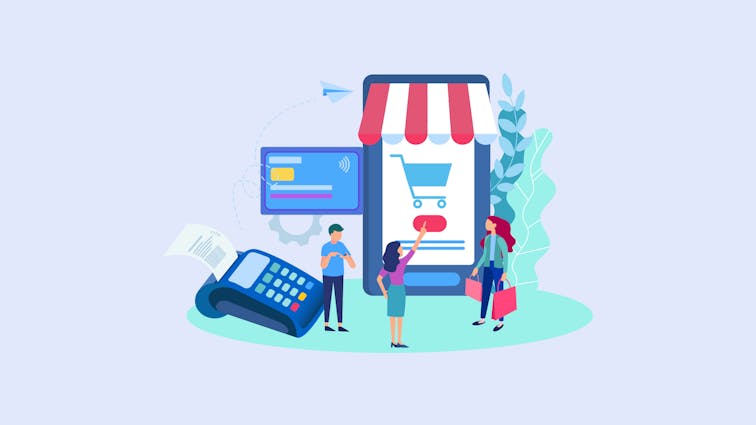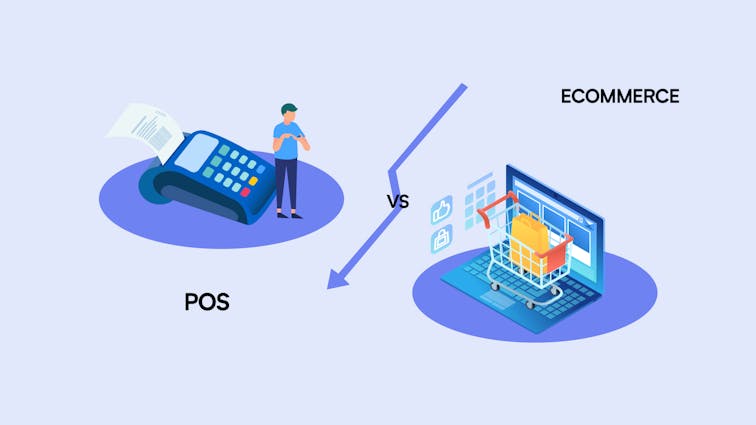
POS and Ecommerce: A Comparative Guide for Today's Retail Landscape
In the dynamic world of retail, two elements have become pivotal in driving business success—Point of Sale (POS) systems and eCommerce platforms.
As the retail landscape continues to evolve, understanding these systems and their roles in modern business is crucial.
This article aims to provide a comprehensive overview of POS and eCommerce, highlighting their importance in today’s retail environment.
Lets dive in it!
Understanding POS and eCommerce: Definitions and Differences

A Point of Sale (POS) system is where your customer makes a transaction. It’s the “checkout counter” of a store in a physical retail environment.
However, in today’s digital age, POS systems have evolved beyond the cash register, encompassing mobile devices and cloud-based software that manage sales, inventory, and customer data.
On the other hand, eCommerce refers to commercial transactions conducted online.
It allows businesses to sell products and services to customers from any location, at any time, through an online storefront.
While both POS and eCommerce systems facilitate sales, their primary difference lies in the sales environment—physical for POS and digital for eCommerce.
Read More: Is Ecommerce a Good Business? Exploring the Potential and Pitfalls of Online Retail
The Importance of POS in Today’s Retail Environment
In the bustling retail environment, a robust POS system is more than just a transactional tool—it’s the backbone of your business operations.
It tracks sales, manages inventory, and collects customer data, providing valuable insights that can drive business decisions.
Moreover, modern POS systems can integrate with other business tools, creating a unified platform for managing various aspects of your business.
The Role of eCommerce in Modern Business
eCommerce has revolutionized the way businesses operate, breaking down geographical barriers and making products accessible to a global audience.
It provides businesses with a cost-effective platform to showcase their products, reach new customers, and generate sales around the clock.
Furthermore, eCommerce platforms offer tools for marketing, analytics, and customer relationship management, empowering businesses to understand and engage their customers better.
The Need for Integration: Bridging the Gap between POS and eCommerce

As businesses strive to provide seamless shopping experiences, the integration of POS and eCommerce systems becomes crucial.
This integration allows for real-time synchronization of inventory and sales data between physical stores and online platforms.
It eliminates the risk of overselling, ensures accurate inventory counts, and provides a unified view of customer data.
By integrating POS and eCommerce, businesses can offer “buy online, pick up in-store” (BOPIS) services, enhancing customer convenience and fostering a seamless omnichannel shopping experience.
In the competitive retail landscape, such integration is not just a nice-to-have—it’s a necessity.
Types of POS Systems and Their Role in eCommerce Integration
There are several types of POS systems available, each with its unique features and benefits. These include:
- Traditional POS Systems: These are the physical cash registers you see in brick-and-mortar stores. They are typically hardware-based and require manual updates and maintenance.
- Mobile POS Systems: These are portable systems that operate on a smartphone or tablet, allowing for sales transactions on the go.
- Cloud-Based POS Systems: These systems store data on the cloud, allowing for real-time access and updates from any location. They are often subscription-based and offer seamless integration with eCommerce platforms.
Key Factors to Consider When Choosing a POS System for eCommerce
When choosing a POS system for eCommerce integration, consider the following factors:
- Integration Capabilities: The POS system should seamlessly integrate with your eCommerce platform, synchronizing data in real time.
- Ease of Use: The system should be user-friendly for both your employees and customers.
- Scalability: As your business grows, your POS system should be able to scale with it.
- Security: The system should adhere to the highest security standards to protect customer data and transactions.
- Customer Support: Choose a provider that offers reliable customer support to resolve any issues promptly.
Read More: Online Business vs Offline Business: Which Is More Beneficial?
The Benefits of eCommerce and POS Integration
Integrating your eCommerce platform with a POS system offers numerous benefits:
- Accurate Product Data: Real-time synchronization ensures product information is consistent across all sales channels.
- Real-Time Inventory Updates: This prevents overselling and helps maintain accurate stock levels.
- Faster Order Processing and Shipping: Integrated systems streamline the order fulfillment process, leading to faster delivery times.
- Improved User Experience: A seamless shopping experience across all channels leads to higher customer satisfaction.
Scenarios for Deploying and Integrating POS with eCommerce Platform
Here are a few scenarios where integrating a POS system with an eCommerce platform would be beneficial:
- Omnichannel Retail: For businesses operating both physical and online stores, integration allows for a seamless shopping experience across all channels.
- Inventory Management: Real-time inventory updates prevent overselling and help maintain accurate stock levels.
- Customer Data Management: An integrated system provides a unified view of customer data, improving CRM and marketing efforts.
In conclusion, the integration of POS systems and eCommerce platforms is a strategic move that can drive efficiency, improve customer experience, and boost sales in the modern retail landscape.
Comparing POS vs eCommerce

While both POS and eCommerce systems facilitate sales, they operate in different environments and offer unique advantages.
POS Systems are typically used in physical retail locations.
They offer immediate, face-to-face customer interaction, which can lead to personalized service and increased customer loyalty.
However, their reach is limited to the store’s location, and they require physical hardware and maintenance.
- Pros: Direct customer interaction, immediate payment processing, ability to offer physical receipts.
- Cons: Limited reach, physical space required, maintenance of hardware.
eCommerce Platforms, on the other hand, operate in the digital space.
They offer a global reach, allowing businesses to sell products anytime, anywhere.
However, they lack the personal touch of a physical store and require reliable internet connectivity.
- Pros: Global reach, 24/7 availability, lower overhead costs.
- Cons: Lack of personal interaction, dependence on internet connectivity, potential for technical issues.
For instance, a local boutique may use a POS system to manage in-store sales, while a global fashion brand might use an eCommerce platform to reach customers worldwide.
The Intersection of POS and eCommerce
In today’s retail landscape, POS and eCommerce don’t have to exist in isolation.
They can work together to create a seamless shopping experience, bridging the gap between physical and digital sales channels.
Integrating POS and eCommerce systems allows for real-time synchronization of data.
This means that inventory and sales data are updated simultaneously across all platforms, preventing overselling and ensuring accurate stock levels.
Additionally, it provides a unified view of customer data, improving customer relationship management and marketing efforts.
Benefits of integrating POS and eCommerce include:
- Real-time inventory updates
- Consistent product information across all channels
- Streamlined order processing and fulfillment
- Improved customer experience
Future Trends in POS and eCommerce
As technology continues to evolve, so too will POS and eCommerce systems. Here are a few predicted trends and advancements:
- Unified Commerce: The integration of POS and eCommerce will continue to deepen, leading to a truly unified commerce experience where all sales channels are seamlessly connected.
- AI and Machine Learning: These technologies will play a larger role in both POS and eCommerce systems, improving data analysis, personalizing customer experiences, and optimizing operations.
- Mobile Payments: The use of mobile payment options will continue to grow, requiring POS systems to adapt and accommodate these changes.
Businesses can prepare for these changes by staying informed about industry trends, investing in scalable and adaptable systems, and prioritizing customer experience in their strategies.
Conclusion
In the ever-evolving retail landscape, understanding and leveraging both POS and eCommerce systems is crucial.
While they offer unique advantages and operate in different environments, their integration can provide a seamless omnichannel retail experience.
As future trends point towards unified commerce, AI integration, and mobile payments, businesses should prepare to adapt and evolve.
By doing so, they can stay competitive, meet customer expectations, and drive success in the modern retail world.
FAQ’s:
1. What is the difference between POS and eCommerce?
POS (Point of Sale) systems are used for transactions in physical stores, while eCommerce refers to online transactions. The key difference lies in the sales environment physical for POS and digital for eCommerce.
2. How does a POS system work in eCommerce?
In eCommerce, a POS system manages online transactions, updates inventory in real-time, and collects customer data, providing a seamless shopping experience across all sales channels.
3. What are the benefits of integrating POS with eCommerce?
Integration of POS and eCommerce provides real-time inventory updates, consistent product information, streamlined order processing, and an improved customer experience.
4. What are the challenges in integrating POS and eCommerce?
Challenges may include technical issues during integration, maintaining data consistency across platforms, and training staff to use the integrated system effectively.








